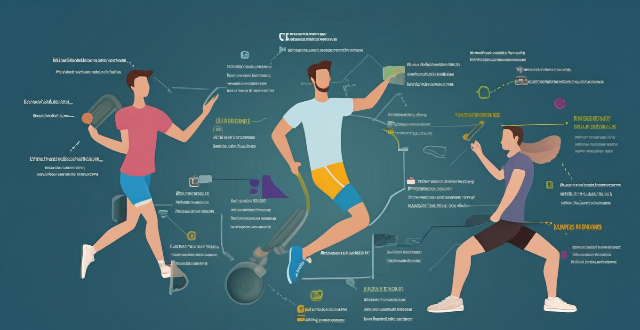Health Intensity

Is it safe for elderly people to engage in high-intensity workouts ?
The safety of high-intensity workouts for elderly people depends on various factors such as health status, fitness level, balance and coordination, recovery time, and necessary modifications and adaptations. It is essential to consult with a healthcare professional before starting any exercise program.

How does exercise physiology explain the benefits of high-intensity interval training (HIIT) ?
High-intensity interval training (HIIT) is a form of exercise that involves short, intense bursts of activity followed by periods of rest or low-intensity exercise. From an exercise physiology perspective, HIIT offers numerous benefits, including increased metabolic rate, improved cardiovascular health, muscle development and endurance, favorable hormonal responses, mental health advantages, reduced injury risk, and time efficiency. These factors make HIIT a popular and effective method for achieving various fitness goals.

Is there a specific duration or intensity of exercise needed to improve immune function ?
The relationship between exercise and immune function is complex, but research suggests that regular physical activity can enhance the immune system. However, both the duration and intensity of exercise play significant roles in achieving this beneficial effect. The American Heart Association recommends at least 150 minutes of moderate-intensity aerobic activity or 75 minutes of vigorous-intensity activity per week for adults. Engaging in prolonged periods of endurance exercise can temporarily suppress immune function due to increased stress on the body. Light activities like walking or yoga can still offer immune benefits by reducing stress and promoting overall health. Regular moderate to high-intensity exercises, such as jogging, cycling, or strength training, are generally considered optimal for enhancing immune function. Adequate rest and recovery are crucial for maintaining a healthy immune system. Combining different types of exercises (aerobic, strength training, flexibility work) can provide a well-rounded approach to enhancing immune function. Staying hydrated and consuming a balanced diet rich in nutrients supports both exercise performance and immune health. Other lifestyle habits, including sleep quality, stress management, and avoidance of harmful substances, also play a vital role in supporting immune function alongside exercise.

How much exercise is needed to see mental health benefits ?
Regular physical activity is known to improve mental health, but the amount of exercise needed varies based on individual factors. The WHO recommends at least 150 minutes of moderate-intensity aerobic activity and muscle-strengthening activities twice a week for adults. Even small amounts of light activity can have mental health benefits, with moderate-intensity activities like brisk walking improving outcomes significantly. Consistency is key, and personalizing your exercise routine based on preferences and capabilities is essential.

How often should I exercise to maintain good bone health ?
Exercise is crucial for maintaining good bone health, but the frequency and intensity required vary depending on individual factors. Regular exercise strengthens bones, improves balance, and reduces the risk of falls and fractures. The recommended exercise guidelines for adults are at least 150 minutes of moderate-intensity aerobic exercise per week and two or more days of strength training per week. For older adults, it's important to consult with a healthcare professional before starting any new exercise program. Other factors that impact bone health include diet, smoking, and overall health status.

How often should seniors engage in aerobic activities for heart health ?
Engaging in regular aerobic activities is crucial for seniors to maintain heart health and overall well-being. The American Heart Association recommends at least 150 minutes of moderate-intensity or 75 minutes of vigorous-intensity aerobic activity per week, spread throughout the week. For seniors, this could include brisk walking, swimming, or biking for at least 30 minutes five days a week (moderate intensity) or running and fast cycling for at least 25 minutes three days a week (vigorous intensity), depending on their capability and medical restrictions. Regular aerobic activity offers numerous benefits for seniors, including improved cardiovascular fitness, better blood pressure and cholesterol levels, weight management, increased muscular strength and endurance, and boosted mental health. However, safety precautions should be taken, such as consulting with a healthcare provider before starting an exercise program, starting slowly, choosing low-impact exercises, staying hydrated, wearing appropriate clothing and footwear, and monitoring bodily responses to the activity. By following these guidelines and taking necessary precautions, seniors can significantly improve their quality of life and maintain their independence longer.

Is there a specific amount of exercise needed per week to see mental health benefits ?
The article discusses the importance of exercise for mental health and explores if there is a specific amount of exercise needed per week to see mental health benefits. It mentions that various health organizations have established guidelines for the recommended amount of exercise per week for adults, focusing on physical health outcomes but also acknowledging the mental health benefits associated with regular exercise. The article suggests that engaging in at least 150 minutes of moderate-intensity exercise per week can lead to significant improvements in mental health, alternatively performing at least 75 minutes of vigorous-intensity exercise per week can also yield positive results. A combination of moderate and vigorous exercises can provide a well-rounded approach to enhancing mental well-being.

How does high-intensity interval training (HIIT) affect cardiorespiratory fitness ?
High-intensity interval training (HIIT) is a form of exercise that involves short bursts of intense activity followed by periods of rest or low-intensity exercise. This type of training can improve cardiorespiratory fitness by increasing the heart rate and improving blood flow throughout the body, leading to improved muscle performance and endurance. HIIT also helps to burn calories and fat, making it an effective way to promote weight loss. Additionally, HIIT workouts can be done in a shorter amount of time than other forms of exercise, making it a great option for those who are short on time but still want to stay active and healthy. Overall, incorporating HIIT into your workout routine can provide numerous benefits for your cardiorespiratory fitness and overall health.

Is high-intensity interval training (HIIT) beneficial for reducing stress ?
The text discusses the potential benefits of High-Intensity Interval Training (HIIT) for stress reduction, including releasing endorphins, improving cardiovascular health, boosting self-confidence, enhancing focus and concentration, and providing a sense of accomplishment. It also provides tips for incorporating HIIT into a routine, such as starting slowly, choosing enjoyable activities, setting realistic goals, incorporating recovery time, and seeking professional guidance.

Is high-intensity interval training (HIIT) more effective for mental health than steady-state cardio ?
This article explores whether high-intensity interval training (HIIT) is more effective for mental health than steady-state cardio. HIIT involves short bursts of intense activity followed by periods of rest or low-intensity activity, while steady-state cardio involves maintaining a consistent level of activity for an extended period. Both types of exercise offer benefits for mental health, such as improved mood, reduced anxiety and stress, increased self-efficacy, relaxation, and social opportunities. However, they may appeal to different individuals based on their preferences and goals. Incorporating both types of exercise into a regular routine can provide the most comprehensive benefits for mental health.

Is it necessary to do a warm-up even for low-intensity workouts ?
A proper warm-up is crucial for any workout, including low-intensity exercises. It increases blood flow and oxygenation, raises muscle temperature, improves range of motion, primes the nervous system, reduces injury risk, and boosts performance. Even for gentle activities like walking or yoga, a warm-up enhances mental focus, gradually activates muscles, promotes consistency, supports joint health, and eases into stretching. Warm-up ideas include walking, dynamic stretching, Tai Chi movements, Pilates exercises, and deep breathing or meditation. Incorporating a warm-up before any workout is essential for maximizing performance, reducing injury risk, and enhancing overall health benefits.

Are there any risks associated with high-intensity workouts for seniors, especially in a group setting ?
High-intensity workouts in a group setting pose certain risks for seniors, including cardiovascular strain, musculoskeletal stress, overexertion and fatigue, and social and psychological factors. To minimize these risks, seniors should consult with a healthcare professional, start slowly and gradually increase intensity, focus on low-impact activities, stay hydrated and monitor temperature, wear appropriate footwear and clothing, listen to their body, and seek supervision from qualified instructors.

How long should my aerobic workouts be ?
Aerobic exercises, or cardio workouts, are vital for overall health and fitness. The American Heart Association recommends at least 150 minutes of moderate-intensity activity or 75 minutes of vigorous activity per week. This can be broken down into shorter sessions throughout the day. Starting slow and gradually increasing duration and intensity is advised. Mixing up activities helps prevent injury and keeps workouts interesting. Benefits include improved cardiovascular health, weight management, mood enhancement, and a stronger immune system. Always consult with a healthcare professional before starting any new exercise regimen.

How can I avoid injury after a high-intensity workout
To avoid injury after a high-intensity workout, it is important to warm up properly, stretch, use proper form, take breaks, stay hydrated, and wear appropriate clothing. These tips will help reduce the risk of injury and allow you to continue enjoying the benefits of high-intensity workouts.

Does high-intensity interval training (HIIT) have specific benefits for chronic disease prevention ?
High-intensity interval training (HIIT) offers numerous benefits for chronic disease prevention, including improved cardiovascular health, enhanced glucose control, reduced inflammation, increased muscle mass and strength, and improved mental health outcomes. To incorporate HIIT into a healthy lifestyle, start slowly, choose the right exercises, include other forms of exercise, and consult with a health professional.

How does climate variability impact the frequency and intensity of extreme weather events like floods and hurricanes ?
Climate variability, which can be natural or human-induced, has a significant impact on the frequency and intensity of extreme weather events such as floods and hurricanes. Changes in rainfall patterns, sea level rise, and land use changes can increase the risk of flooding, while warmer ocean temperatures, atmospheric conditions, and El Niño Southern Oscillation (ENSO) can affect hurricane formation and intensity. As our planet continues to warm due to human activities, it is crucial that we take steps to mitigate the impacts of climate change and adapt to its effects on our environment and communities.

Can aerobic exercise improve my cardiovascular health ?
Aerobic exercise is essential for maintaining and improving cardiovascular health, offering benefits such as strengthened heart muscle, lowered blood pressure, increased HDL cholesterol, reduced inflammation, weight management, improved circulation, and better blood sugar regulation. Regular aerobic activities like walking, jogging, cycling, swimming, or group fitness classes can significantly enhance overall heart health. The American Heart Association recommends at least 150 minutes of moderate-intensity aerobic exercise weekly, spread throughout the week, to achieve these benefits.

How much exercise do I need to maintain good cardiovascular health ?
Maintaining good cardiovascular health requires regular exercise, with the American Heart Association recommending at least 150 minutes of moderate-intensity aerobic activity or 75 minutes of vigorous-intensity aerobic activity each week, along with two or more days of muscle-strengthening activities. The amount of exercise needed may vary depending on individual needs and fitness level, and other lifestyle factors such as diet, stress management, sleep, and avoiding smoking and excessive alcohol consumption can also contribute to good cardiovascular health.

How can I create a sustainable fitness routine for better health ?
Creating a sustainable fitness routine is crucial for maintaining good health and achieving long-term fitness goals. Here are some tips on how to create a sustainable fitness routine: ## 1\. Set Realistic Goals * **Start Small:** Begin with small, achievable goals that you can gradually build upon. This will help you avoid burnout and stay motivated. * **Be Specific:** Clearly define your fitness goals, such as losing weight, gaining muscle, or improving cardiovascular health. ## 2\. Choose an Activity You Enjoy * **Find Your Passion:** Select an exercise that you genuinely enjoy, whether it's running, swimming, cycling, or dancing. This will make it easier to stick to your routine. * **Mix It Up:** Incorporate variety into your workouts by trying different activities or switching up your routine regularly. ## 3\. Make It Part of Your Daily Routine * **Schedule It In:** Treat your workouts as non-negotiable appointments in your calendar. Plan them around your work and personal life commitments. * **Create a Habit:** Aim to exercise at the same time each day to establish a consistent habit. ## 4\. Track Your Progress * **Keep a Journal:** Record your workouts, including the type of exercise, duration, and intensity. This will help you monitor your progress and adjust your routine accordingly. * **Set Milestones:** Celebrate small milestones along the way to stay motivated and focused on your long-term goals. ## 5\. Stay Accountable * **Find a Workout Buddy:** Having a friend or family member to exercise with can provide motivation and accountability. * **Join a Group Class:** Enrolling in group fitness classes can also offer social support and encouragement from others working towards similar goals. ## 6\. Listen to Your Body * **Rest and Recovery:** Allow adequate rest days between workouts to prevent injury and promote recovery. * **Adjust Intensity:** Pay attention to how your body feels during and after exercise. If you're feeling excessively fatigued or experiencing pain, consider reducing the intensity or duration of your workouts. By following these tips, you can create a sustainable fitness routine that supports better health and long-term success. Remember to be patient with yourself and celebrate every step towards achieving your fitness goals!

How can I create a sustainable workout plan to enhance my personal health ?
Creating a sustainable workout plan is crucial for enhancing personal health. To do so, start by setting realistic goals that are specific, measurable, attainable, relevant, and time-bound (SMART). Choose activities you enjoy and mix up your routine with different types of workouts to avoid boredom. Start slowly and gradually increase intensity while incorporating rest days to prevent injury and burnout. Track your progress using a journal or fitness app and stay consistent and accountable by finding support from an accountability partner or fitness community. By following these steps, you can create a sustainable workout plan that enhances your personal health while keeping you motivated and engaged in the long term.

How long should my gym sessions be to maximize results ?
Maximizing Gym Sessions for Optimal Results: The duration of your gym sessions can significantly impact your results. To maximize your outcomes, consider factors such as your goals, fitness level, and schedule. Recommended durations vary based on goals: muscle building requires 60-90 minutes, weight loss benefits from 30-45 minutes of HIIT or circuit training, and cardiovascular health improves with 30-60 minutes of moderate-intensity workouts. Intensity matters, with shorter high-intensity workouts being more effective for fat loss and longer moderate-intensity sessions building endurance. Listen to your body and adjust accordingly, allowing for adequate rest and recovery days to prevent injury and promote muscle growth.

What are the key indicators of good personal health ?
Good personal health involves taking care of both physical and mental well-being. Key indicators include regular exercise, a balanced diet, adequate sleep, stress management, regular check-ups, and mental well-being. By focusing on these aspects, you can lead a fulfilling life with improved overall health and well-being.

How do climate losses and damages impact human health ?
This article discusses the impact of climate change on human health, highlighting various ways in which climate losses and damages can affect well-being. It covers topics such as extreme weather events causing physical injuries and illnesses, worsening air quality leading to respiratory problems, food insecurity resulting in malnutrition, increased waterborne diseases due to warmer water sources, and mental health issues arising from displacement and migration. The article emphasizes the need for a comprehensive approach to address these challenges, including mitigating greenhouse gas emissions, adapting to changing conditions, and providing support for vulnerable populations.

What are the benefits of swimming for overall health and fitness ?
Swimming offers numerous benefits for overall health and fitness, including improved cardiovascular health, muscle strength and tone, joint mobility and flexibility, weight management, mental health, injury recovery and rehabilitation, and socialization. It is a low-impact, high-intensity workout that engages all major muscle groups in the body, making it an effective way to build strength and tone muscles without putting undue stress on the joints. Additionally, the buoyancy of water helps to reduce pressure on the joints, making swimming an ideal exercise for people with arthritis or other joint issues. Swimming also burns a significant number of calories, making it an effective way to manage weight. The rhythmic nature of swimming can be meditative, helping to clear the mind and promote relaxation. Overall, swimming is a great way to improve overall health and fitness.

Are certain durations or intensities of exercise more beneficial for cognition than others ?
Exercise has been shown to improve cognitive function, memory, and mental health. Both short-term and long-term exercise can enhance different aspects of cognition. Moderate-intensity exercise is most beneficial for older adults, while high-intensity exercise may also be advantageous but should not exceed certain levels. Aerobic exercise, resistance training, and balance exercises all contribute to cognitive improvement. Individual differences should be considered when determining the optimal exercise regimen for cognitive enhancement.

What is the difference between cardiovascular and resistance training in health management ?
The text discusses the differences between cardiovascular and resistance training, highlighting their unique benefits and examples of each. Cardiovascular training strengthens the heart, aids in weight management, and improves endurance, while resistance training enhances muscle strength, bone density, and metabolism. Combining both types of exercise leads to a well-rounded fitness regimen that addresses multiple aspects of health, including endurance, strength, flexibility, and balance. The text suggests ways to incorporate both forms of exercise into a workout routine for optimal health management.

Why is it a mistake to believe that more exercise automatically leads to better health ?
The belief that more exercise automatically leads to better health can be a mistake due to several reasons such as overexertion and injury risk, neglect of other aspects of health, cardiovascular strain, hormonal imbalances, and mental health impact. It is important to recognize that more is not always better and a balanced approach that incorporates appropriate amounts of exercise along with attention to nutrition, rest, and overall wellness is key to achieving optimal health outcomes.

What types of exercises are most effective in preventing chronic illnesses ?
The article discusses various types of exercises that are most effective in preventing chronic illnesses. It mentions aerobic exercises such as walking, running, cycling, and swimming; strength training including weightlifting, resistance bands, and bodyweight exercises; flexibility and balance activities like yoga, tai chi, and pilates; high-intensity interval training (HIIT); and combination workouts like circuit training and group fitness classes. The article also emphasizes the importance of consistency, variety, progression, and individualization in exercise routines to achieve long-term health benefits.

Can regular exercise help with insomnia ?
Insomnia, a sleep disorder making it hard to fall or stay asleep, affects many. Regular exercise is emerging as a natural remedy for insomnia. Exercise can positively impact sleep quality and duration by regulating the circadian rhythm and releasing endorphins. It also reduces stress and anxiety, leading causes of insomnia. Regular exercise boosts energy levels and mental health, further promoting better sleep. The recommended amount is 150 minutes of moderate-intensity activity weekly, including muscle-strengthening exercises. Tips for exercising with insomnia include choosing low-impact activities, avoiding high-intensity workouts at night, establishing a routine, being mindful of caffeine intake, and consulting a doctor before starting an exercise program.

How often should I run during marathon preparation ?
Running is an essential component of marathon training, but how often should you run during preparation? This article will explore the optimal frequency and duration of running sessions for marathoners in their preparation phase. The importance of running cannot be overstated as it helps to build endurance, improve cardiovascular health, and increase muscle strength. The right frequency of running depends on your fitness level and the intensity of your training plan. Beginners should start with one or two runs per week and gradually increase the number as fitness improves. Experienced runners may be able to run four or five times per week without overtraining. The duration of each running session also depends on your fitness level and the intensity of your training plan. Beginners should aim for short runs at a moderate intensity while experienced runners can run longer distances at a higher intensity. Overtraining can lead to injury and burnout, so it's essential to listen to your body and give yourself enough recovery time between runs. Other factors such as terrain, weather conditions, and personal preferences can affect how often you should run during marathon preparation. It's important to adjust your training plan accordingly and avoid running in extreme conditions if possible. By following a well-structured training plan and adjusting your workouts based on personal preferences and environmental factors, you can achieve success in your marathon race!